|
"Floratam is a vigorous, coarse textured St. Augustine grass
variety."
==============================================================
"Stolons of Floratam are large, purplish-red in color (demand
this characteristic when purchasing sod)"
===========================================================
with internodes averaging 3 inches in length.
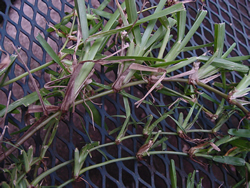
Internodes (stem between groups of grass blades) average 3 inches
in length in the top Floratam compared to the smaller two pieces
of common St. Augustine
=======================================================
Leaf blades are wider and longer than common St. Augustine grass.
========================================================
Hopefully these images and descriptions can help you avoid the
problem sent to me in an e-mail on June 18, 2007.
geographic_location: San Antonio, TX
I bought 12 pallets ($145 per pallet which is $15 per pallet
more than any other St. Augustine hybrid and $45 per pallet more
than Raleigh!!) of Floratam St. Augustine. It wasn't until after
it was down that I went online to learn more about it. That's
when I learned that Floratam has characteristics my grass does
not have (purple stolons and this grass produces seeds, it's my
understanding Floratam does not). The people I bought it from
insist it is Floratam. How can I get it tested or who could I
contact to examine it to tell me for sure? I really only want
to confirm I got what I ordered and paid a premium price for.
I really appreciate any advice you can give me. Thanks!
ANSWER: I regret to inform you that you DO NOT
have Floratam. David Rodriguez, Bexar County Extension Horticulturist,
and I visited your lawn on Friday, June 29, 2007, and found no
Floratam planted in your lawn. Our best guess is that you have
been sold Raleigh. You should be able to recover the $180 ($15
per pallet more for Floratam X 12 pallets) difference you paid
for the Floratam which you did NOT get. If the people who sold
you the mislabeled grass complain, please inform them that $180
is much less than removing and replacing THE ENTIRE PLANTING!!!
Sorry this happened and we are working to insure that it does
not happen again. THANKS for calling this turf fraud to our attention.
Better late than NEVER. Below are more images taken at the SAWS
Drought Test Turfgrass Plots in southern Bexar County on June
29, 2007, to assist other in identifying the real Floratam St.
Augustinegrass.
============================================
On Friday, June 29, 2007, David Rodriguez, Brady Yecker - a horticulture
intern and A&M senior in horticulture, Mark Peterson-Project
Coordinator - Conservation San Antonio Water System, and Jerry
Parsons, Professor and Extension Horticulturist, went to the drought
study site at Bladerunner Farms (Leon Creek). Mark Peterson had
a map to the first planting but did not have the plot plan for
the second planting. After arriving, Parsons told Mark NOT to
show the map or tell where the Floratam plots were located. This
site is planted in a randomized, replicated (four times) design.
The original (first planted) plot was independently examined by
Parsons and Rodriguez. A decision was then voiced as to which
were the Floratam plots or sections. Rodriguez and Parsons identified
ALL FOUR PLOTS OF FLORATAM within four minutes-NO MISTAKES as
confirmed by Mark Peterson with the plot plan. Brady Yecker, who
had never seen different grass varieties side-by-side identified
ALL FOUR PLOTS OF FLORATAM in the second plot planting -- for
which we had no map - within five minutes with NO MISTAKES!!!
The following images tell the story.
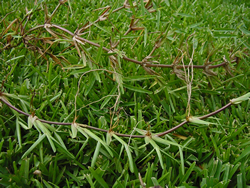
Runners with purple stems, healthy foliage and long, white
roots clearly identifies the real Floratam. |
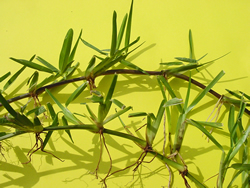
The top, purple-stemmed Floratam grass has characteristic
healthy blades and white roots while the bottom St. Augustine
grass has diseased leaf blades and brown roots. |

This image of Sapphire shows another
St. Augustine that has purple stems as does Floratam but
does not seem to perform nearly as well as Floratam in drought
studies and has a much smaller leaf mass, smaller stem,
shorter internodes, and diseased foliage.
|
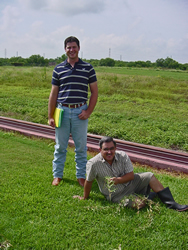
It is difficult to see different textures and color hues
in images of grass. Brady (left) is standing in a different
St. Augustine and David (right) is sitting in Floratam with
his hand resting on the dividing line between St. Augustinegrass
selection. Floratam texture is coarser and the color is
more blue-green than green. |
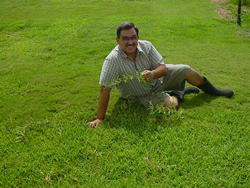
David Rodriguez is sitting in Floratam with his hand on
the dividing line between St. Augustinegrass varieties at
the SAWS Drought planting. |
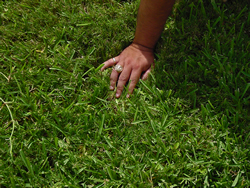
Notice the coarser, thicker Floratam to the right (in the
image) of David's hand marking the division of the varieties
compared to the sparseness of the grass to the left side
of the image. Also notice the Floratam runners INVADING
surrounding, weaker varieties. |
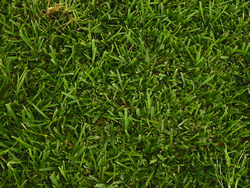
This is pure Floratam St. Augustinegrass which is blue-green
rather than green and is described in the official Texas
A&M Variety Release in 1972. |
|
|



